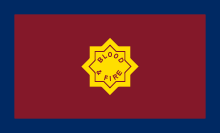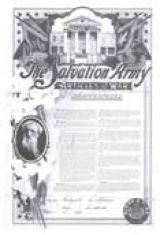Salvation Army Terminology
Because The Salvation Army operates according to a military structure (yes, we really are an Army!), you will come across some terminology that may be unfamiliar to you. Here’s a few phrases and commonly-used abbreviations to help.
Terminology
Adherent: A person who regards The Salvation Army as his/ her spiritual home but has not chosen to make the commitment of 'soldiership' in The Salvation Army
Articles of War (Soldier’s Covenant): this is the statement of beliefs and promises which every intending soldier is required to sign before enrolment.
“Blood & Fire”:The Salvation Army’s motto, referring to the symbolism of the sacrificial blood of Jesus Christ and the purifying, illuminating fire of the Holy Spirit
Cadet: A Salvationist undertaking theological and practical training for officership. The first cadets were trained in 1879.
Candidate:a soldier who has been accepted to enter training as an officer
Captain: automatic rank given to ordained Salvation Army officer after 5 years of service
Chief of the Staff: this is the leader second in command of The Salvation Army worldwide. He or she is chosen by the General.
Citadel: used to refer to the property or church building where Salvationists meet for worship. Other terms used are 'fortress', 'barracks' and 'temple'. Today all Salvation Army buildings are referred to as the corps (see the word Corps for explanation).
Colonel: this is a rank appointed to Salvation Army officers on merit by the General.
Command:A smaller type of Salvation Army Territory directed by a designated 'Officer Commanding'
Commissioner: this is the highest rank of a Salvation Army officer except General, and is appointed on merit by the General. Most Territorial Commanders are Commissioner in rank, although some are Colonels.
Congress:Central gatherings held in divisions, regions, territories or internationally, attended by officers and their fellow Salvationists
Corps: (french word pronounced ‘core’) is a Salvation Army church, similar in concept to that of a parish, sometimes comprising several congregations.
Corps Cadet: A young Salvationist who undertakes a course of Bible study, Salvation Army doctrine and history, and practical training in his/her corps
Commanding Officer (CO): Male and/or female ordained Salvation Army clergy who leads a Salvation Army Corps.
Corps Sergeant-Major (CSM): Similar to the chief 'elder' or lay leader in other Christian denominations, the CSM is the chief local officer for public work who assists the corps officer with meetings (worship services) and usually takes command and responsibility in the corps officer’s absence.
Dedication Service: The Salvation Army's equivalent to a christening service, it consists of a public presentation of infants to God. It differs from christening or infant baptism in that the main emphasis is upon specific vows made by the parent/s concerning the child's/children's upbringing.
Division:a grouping of districts, similar to a diocese in the Anglican Church. Territories are divided into Divisions, each of which has a number of Corps and social centres which are mostly run by officers.
Divisional Commander (DC): the leader of a Salvation Army Division
Divisional Headquarters (DHQ): the administrative headquarters of a Division.
Farewell Orders: the transfer of officers to new appointments
Furlough: holidays for officers
General: The General is the officer elected (by the High Council) to lead The Salvation Army worldwide, and is based at International Headquarters in London. All appointments are made, and all regulations issued, under the General's authority
High Council:A group called together on a needs-basis, the High Council elects the General in accordance with The Salvation Army Act 1980.The High Council comprises the Chief of the Staff, all active (as opposed to retired) commissioners except the spouse of the General, and all territorial commanders
International Headquarters (IHQ): the General directs Salvation Army operations throughout 108 countries of the world through the administrative departments of International Headquarters (IHQ) in London, which are headed by International Secretaries
International Secretary: An officer appointed by the General to supervise administrative departments at International Headquarters representing various parts of Salvation Army work worldwide.
Junior Soldier: A boy or girl who, having come to faith in Christ and signed the Junior Soldier's Promise, is enrolled as a Salvationist.
League of Mercy: Now known as Community Care Ministries, League of Mercy commenced in 1892 to respond to spiritual and social needs through visitation in the local community
Lieutenant: rank given to newly ordained salvation Army officers.
Lieutenant-Colonel:this is a rank appointed to Salvation Army officers on merit by the General.
Local Officer: A soldier appointed to a position of responsibility and authority in the corps, who carries out the duties of the appointment without being separated from his/her regular employment/lifestyle and without receiving remuneration from The Salvation Army
Major: this is the rank of a Salvation Army officer who has completed further studies and 15 years service.
Meeting: church worship service
Mercy Seat (penitent form, holiness table): A bench or table provided as a place where people can kneel to pray, seeking salvation or sanctification, or making a special consecration of their life to God's will and service
Officer: ordained Salvation Army clergy, who wear uniforms with red epaulettes indicating their rank
Order of the Founder (The): This order of merit marks meritorious Christian example and witness, and distinguished or memorable service
Order of the Silver Star (The):Inaugurated in the USA in 1930, and extended internationally in 1936, this order expresses gratitude to parents of commissioned officers in The Salvation Army
Outpost:A locality in which Army work is carried on and where it is hoped a society or corps will develop
Penitent form:see Mercy Seat
Promotion to Glory:The Army's description of the death of Salvationists, with 'glory' symbolising life after death in God's presence.
Quarters:This refers to the house provided for Salvation Army officers and their families.
Ranks:Officers in The Salvation Army have different ranks. These include Cadet, Lieutenant, Captain, Major, Lieut-Colonel, Colonel and Commissioner.
Red Shield: a widely recognised Salvation Army symbol of caring service for those in need.
Red Shield Appeal:An annual financial appeal to the general public to help fund The Salvation Army's extensive social program.
Salvation:The work of grace which God accomplishes in a repentant person whose trust is in Jesus Christ. The deeper experience of this grace, known as holiness or sanctification, is the outcome of wholehearted commitment to God.
SAGALA (Salvation Army Guards And Legion Association): A branch of work with children from The Salvation Army and the wider community, similar to girl guides/boy scouts
Salvationist:member of The Salvation Army, whether an officer or soldier
Secretary:A headquarters departmental head
Soldier:lay member of The Salvation Army (ie. church members who are non-clergy)
Songster Bridgade:Salvation Army choir
Swearing-in:The public enrolment of Salvation Army soldiers
Timbrel:musical instrument, similar to a tambourine
Territory:for administrative purposes, The Salvation Army internationally is divided into world Territories. Usually each country forms a single Salvation Army Territory, but some where the Army is numerically strong are divided into two or more.
Territorial Commander (TC):the leader of a Salvation Army Territory.
Territorial Headquarters (THQ):the administrative headquarters for a Territory.
War Cry:The Salvation Army's official flagship journal, many issues of which are published in many countries. The War Cry was first published in 1879
Young People’s Sergeant Major (YPSM):A local officer responsible for the children's & youth work, under the commanding officer/s.
Abbreviations
Here are a few commonly used abbreviations:
CO: Commanding Officer
CSM: Corps Sergeant-Major
DC: Divisional Commander
DHQ: Divisional Headquarters
IHQ: International Headquarters
TC: Territorial Commander
THQ: Territorial Headquarters
YPSM: Young People's Sergeant Major
